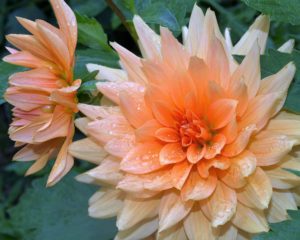
Another Season of Bulbs
Dahlias produce vivid, sophisticated blossoms that bloom from summer right through the fall.
By Thomas Christopher
Because we focus so on the spring-flowering bulbs, we often forget that bulbs also offer another season of color. There are, after all, a host of bulbs that if planted in late spring bloom in summer and even on into fall. In this way, they provide color when the flower garden may otherwise be lackluster.
These summer flowering bulbs share the fail-safe quality of their spring-flowering fellows. Because the bulbs when you get them from the supplier are full of stored energy, they are almost certain to bloom well in their first year in your garden. Given reasonable care, that performance will be repeated for many more years thereafter, for virtually all summer-flowering bulbs are perennial, though most cannot over-winter outdoors in our climate. You can, of course, treat them as annuals, planting new bulbs every spring, but that’s an unnecessary extravagance for it’s easy enough to bring them indoors as the weather cools in fall.
One type of summer-blooming bulb that is winter hardy in our region is the true lilies, members of the genus Lilium. There are a number of lilies native to our region. I’m particularly fond of the Canada lily (Lilium canadense), a wildflower of moist meadows whose upright 2 to 4-foot stems bear speckled trumpets of yellow, orange or red. Not a native but easily naturalized is the Asian tiger lily (Lilium lancifolium), which spread throughout my garden before a plague of introduced scarlet lily beetles wiped them out. Unfortunately, to grow lilies in New England or New York these days, you must be scrupulous about picking off and killing the adult beetles and their larvae as they appear or else spray regularly with some insecticide such as neem oil.
I prefer to grow the less hardy but more pest-free exotic summer bulbs. The bold foliage of elephant ears (Colocasia spp.) and caladiums (Caladium bicolor) add a flamboyant, tropical note to semi-shaded beds. Both, if kept moist, will also flourish in sunny spots.
Other sun lovers are the cannas (Canna spp.) which match colorful, often striped, large leaves with equally spectacular red, orange, or yellow, often bi-colored, flowers. Gladioluses also flourish in well-drained soils where they receive at least 8 hours of sunlight a day and their spikes of bright color can energize the garden as well as providing cut flowers for the house. Pineapple lilies (Eucomus spp.) is a mid to late summer conversation-starter with its cylindrical spike of flowers topped with a tuft of leafy bracts, reminiscent of a pineapple in profile as the name suggests.
My favorite of the summer bulbs is, unexpectedly, dahlias. I had always dismissed these as tacky until their beauty was brought forcefully to my attention by my wife. I’ve since seen them used to great effect in many gardens where their vivid but also sophisticated blossoms inject vitality into the plantings from summer well into the fall.
Don’t plant summer bulbs until the soil has warmed to 60°F – the same time as you plant out tomato seedlings. Amend the soil with compost so that it is moisture-retentive but also well drained. In general, you should plant the bulbs at a depth equal to three times their diameter, taking care to set them with their pointed side up and root side down. If you can’t tell which is the bottom of the bulb, set it on its side. Sprinkle a little high-phosphorus bulb fertilizer over the bottom of the hole at planting time. Dahlias, which come as clusters of tubers rather than bulbs, should be planted in holes excavated to a depth of 8-12 inches and then refilled with soil amended with compost until the tubers rest at a depth of 2-4 inches. Water whenever the soil dries out and fertilize with a plant food formulated for flowers when the shoots emerge from the ground.
Lilies may be allowed to overwinter in place, but the other summer bulbs must come indoors when the first frost blackens their foliage. Cut back the stems to a length of 2-4 inches, and dig the bulbs from the ground, taking care not to wound them. Spread them out on newspaper in a frost-free place to dry for a couple of days, then bury them in layers in a carton filled with peat moss, making sure that none of the bulbs touch each other. Store the carton in a cool corner of the cellar, and you’ll have summer bulbs ready for the planting the following spring.
Thomas Christopher is the co-author of “Garden Revolution” (Timber Press, 2016) and is a volunteer at Berkshire Botanical Garden. berkshirebotanical.org
Be-a-Better-Gardener is a community service of Berkshire Botanical Garden, one of the nation’s oldest botanical gardens in Stockbridge, MA. Its mission to provide knowledge of gardening and the environment through 25 display gardens and a diverse range of classes informs and inspires thousands of students and visitors on horticultural topics every year. Thomas Christopher is the co-author of Garden Revolution (Timber press, 2016) and is a volunteer at Berkshire Botanical Garden. berkshirebotanical.org.



